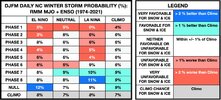Although there is a split in the contours here, an actual hardcore split would be when the entire Strat PV splits into completely separate 'daughter' low anomalies. So, this is showing an SPV that is stretched and pushed off the NPole a bit, which is how a SSW Displacement would be. But either way, the SPV is highly disturbed right now. The NASA GEOS MERRA forecast shows the lower stratosphere dropping to record / near record lows in mid-Jan (100mb)
This image is from the 06z GFS run. This covers the full stratosphere and troposphere (1mb down to 1000mb). The blue coloring shows how the zonal winds are weaker than normal thru the stratosphere with some downwelling occurring in the forecast. Source:
http://weatheriscool.com/
You can get some good Strat images for free here with the NASA GMAO GEOS forecasts. Note that images can be slow to load when you click on them on that site (i.e. Animate button), but otherwise the loops work well once loaded. Source:
https://fluid.nccs.nasa.gov/wxmaps//









